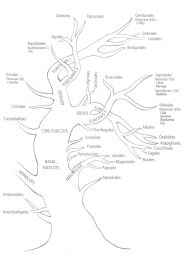
Caffeine and related molecules (see chemical structures of purine alkaloids (PuA)) provide the plant producing them not only with an ideal nitrogen storage but also with an effective chemical defense. Generally, PuA are accumulated in the youngest vegetative parts of the plant, and we find them also in seeds indicating their species-protecting function. Of course, human beings benefit from this allocation pattern: We enjoy the cup of invigorating tea prepared from buds and youngest leaves, as well as the coffee brew and the chocolate bar, both derived from generative plant parts, the seeds.
Let us beginn first by 'chemical defense', a term signifying somehow an anthropogenic sight onto nature. However, if we analyze how the plant does synthesize and allocate PuA, and how potential predators are affected by these compounds, we will be able to substantiate their plant protecting function.
Allocation of PuA
More than 40 years ago we started investigating the biosynthesis, transport and tissue-specific accumulation of caffeine and found as others before, that within the coffee plant there is a caffeine concentration gradient decreasing from the tip to the base (Baumann & Wanner 1972).
Moreover, we showed the time course of caffeine accumulation in the coffee fruit (Keller et al. 1972): After an initial rise (see columns), the pericarp caffeine levels off, whereas seed caffeine increases almost exponentially to reach a high value already after 4 to 5 months. Growth in terms of dry weight is biphasic for the pericarp and stepless for the seed. Hence, the young and soft coffee fruit is protected by high caffeine in the green pericarp, later on, when the tough endocarp and the hard seed develop, the pericarp gets red, sweet and juicy with a low relative caffeine content (ca 0.2 %), altogether a syndrom for dispersal by animals such as birds (e.g. Jacu) and mammals (e.g. monkeys).
Here I have summarized some facts about the caffeine allocation in the coffee plant. We are lucky, that the authorities in Trieste made the ESPRESSO COFFEE book freely accessible!
Here we see the glass of our greenhouse sheltering almost all caffeine plants used by humans. Since slugs and snails don‘t like caffeine (Hollingsworth et al. 2002, 2003), they avoided our plants and in their place preferred the algae covering the inside of the glazing. We recognize the feeding tracks left by the individual teeth of the radulae of slugs of different size.
Gorgonian corals, also called sea fans, are known to produce caffeine and related substances (Parameswaran et al. 2002, Sorek et al. 2007) , which may defend them against marine mollusks – a keen hypothesis!

biochemical ecology
The 'Caffeines'
The
Caffeine Plants


